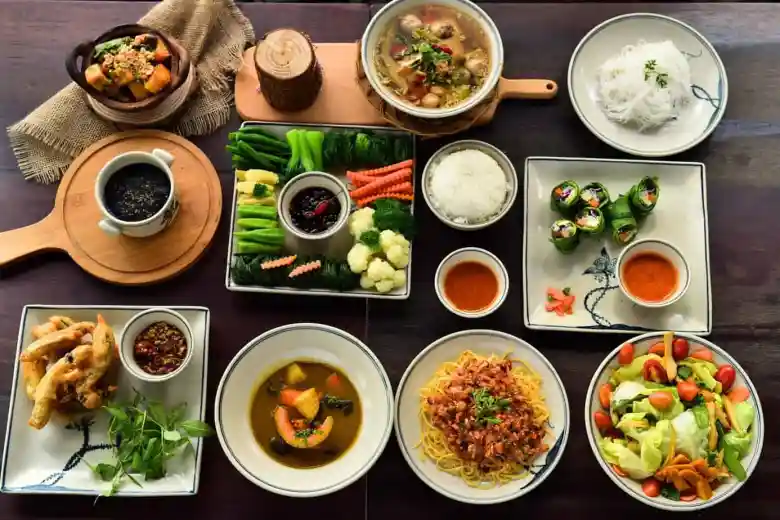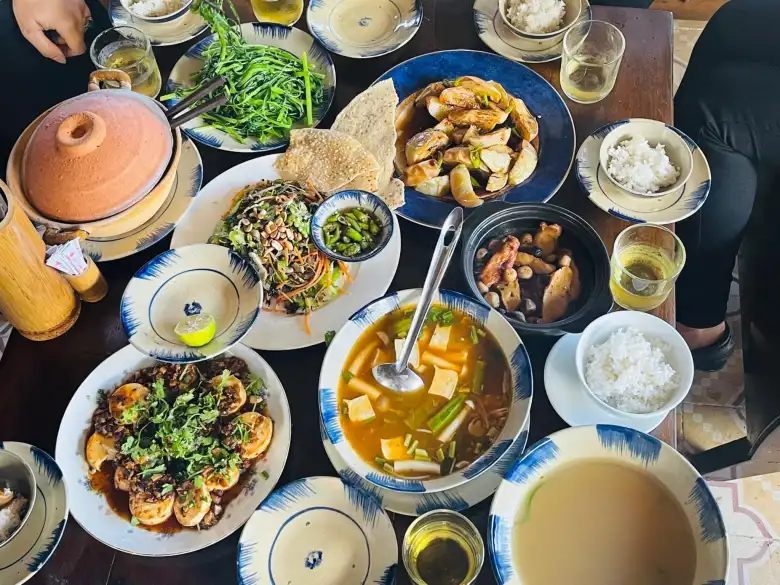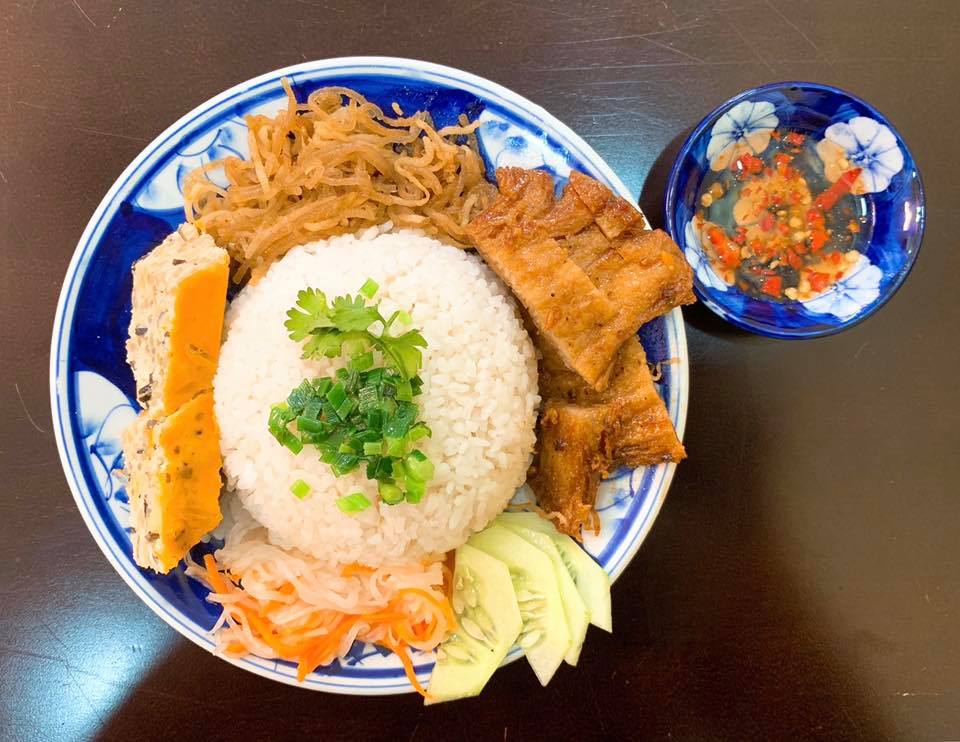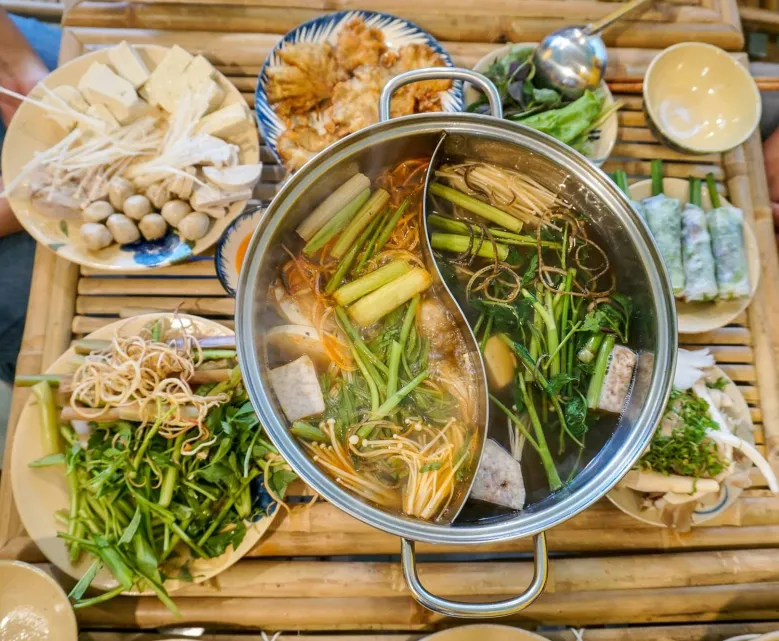Vietnam with its thousand-year-old history and rich culinary tradition, offers a unique experience for Western vegetarian travellers. Vietnamese cuisine, deeply rooted in the country’s culture, proves surprisingly suitable for a meat-free diet thanks to its emphasis on fresh vegetables, herbs and plant proteins. This article will explore vegetarian cuisine and Vegetarian dishes in Vietnam detail when placing it in the broader context.
First of all, it is useful to know how to say ‘vegetarian’ in Vietnamese. The main term is ‘ăn chay’ (pronounced ‘an ciai’), which literally means ‘eating vegetarian’. Thus, to say ‘I am vegetarian’, the phrase ‘Tôi ăn chay’ (pronounced ‘toi an ciai’) is used.
The tradition of vegetarian cuisine in Vietnam
Vietnamese cuisine is the result of centuries of diverse influences, from Chinese domination to French occupation, via the culinary traditions of neighbouring countries such as Cambodia and Thailand. Despite these external influences, Vietnamese cuisine has maintained a strong identity, characterised by the use of fresh ingredients and a harmonious balance of flavours.

Buddhism, which has been present in Vietnam for over 2000 years, has had a significant impact on the country’s food culture. Many Vietnamese practice vegetarianism for limited periods, often in conjunction with religious holidays or on certain days of the lunar month. This tradition has helped develop a rich variety of vegetarian dishes, making Vietnam an ideal destination for travellers who follow this dietary style.
Key ingredients of vegetarian cuisine in Vietnam
Vietnamese vegetarian cuisine is based on a rich variety of ingredients. Tofu is known as ‘đậu phụ’ and is a staple in many recipes.
Fresh vegetables play a crucial role. These include bok choy, called ‘cải thìa’ in Vietnamese, the tender bamboo shoots or ‘măng’. This abundance of vegetables guarantees not only flavour, but also an important nutritional intake.
Aromatic herbs are another distinctive element of Vietnamese cuisine, imparting unique aromas and flavours to dishes. Thai basil (húng quế), coriander (rau mùi), mint (bạc hà) and lemongrass (sả) are just some of the herbs that characterise this cuisine, adding freshness and complexity to dishes.

Rice and noodles form the basis of many Vietnamese dishes, available in different varieties to suit every culinary need. Rice, called ‘cơm’, is a staple food, while noodles can range from ‘phở’ to ‘bún’ or ‘mì’, each with its own unique characteristics to suit different types of preparations.
Mushrooms are widely used in Vietnamese vegetarian cuisine, adding flavour and texture to dishes. Especially popular are shiitake mushrooms, known locally as ‘nấm hương’, prized for their rich flavour and meaty texture.
The end, tropical fruits further enrich the palette of available flavours. The jackfruit (mít), the controversial but beloved durian (sầu riêng) and the sweet longan (nhãn) are just a few examples of the wide range of fruits that can be found and enjoyed in Vietnam, either as snacks or as ingredients in more elaborate dishes.
This rich variety of ingredients allows Vietnamese vegetarian cuisine to be not only nutritious and healthy, but also incredibly varied and tasty, offering a culinary experience that satisfies all the senses.
Must-try vegetarian dishes in Vietnam
Phở chay: The vegetarian version of the famous Vietnamese soup deserves special attention. Prepared with a rich broth of vegetables and spices, it is served with rice noodles, tofu, mushrooms and a variety of fresh vegetables. The complex flavours this dish offers make it a must for any vegetarian travelling in Vietnam.
Bánh xèo chay: A crispy crepe made of rice flour and turmeric, filled with soya bean sprouts, mushrooms and vegetables, served with lettuce leaves and herbs. This dish offers a unique tactile experience as it is eaten by wrapping pieces of crepe in lettuce leaves.

Cơm tấm chay: A dish of broken rice, accompanied by a variety of vegetarian side dishes such as grilled tofu, sautéed vegetables and ‘mock eggs’ made with tofu. This dish represents Vietnamese skill in creating vegetarian versions of traditionally meat-based dishes.
Gỏi cuốn chay: Fresh, non-fried spring rolls wrapped in rice paper and filled with rice vermicelli, tofu, crispy vegetables and herbs. Served with a peanut sauce, they offer the perfect combination of freshness and flavour.
Bún chả chay: A noodle soup served with fried vegetarian spring rolls, fresh vegetables and a sweet and sour sauce. This dish represents the balance of hot and cold, crispy and soft elements typical of Vietnamese cuisine.
Food philosophy in Vietnamese culture
To fully understand Vietnamese vegetarian cuisine, it is important to consider the philosophy of food in the country’s culture. The Vietnamese see food not only as nourishment, but as a means of maintaining balance in the body. This concept derives from traditional medicine and is reflected in the attention paid to balancing ‘yin’ (cold) and ‘yang’ (hot) elements in each meal.
In addition, sharing food is a fundamental aspect of Vietnamese culture. Meals are often served with several plates placed in the centre of the table to be shared. This style of service lends itself particularly well to vegetarians, as it allows them to sample a variety of dishes in one meal.

Practical tips for vegetarian travellers in Vietnam
- Learn a few key phrases:
‘Tôi ăn chay’ (I am a vegetarian)
‘Không thịt’ (Meatless)
‘Không cá’ (Without fish)
‘Không nước mắm’ (Without fish sauce)
- Explore local markets: They are a window into local food culture and offer a wide range of fresh fruit and vegetables. Try asking for local produce using Vietnamese names to make a connection with the vendors.
- Look for Buddhist restaurants: Called ‘quán chay’ or ‘nhà hàng chay’, they offer fully vegetarian and vegan menus, often with ‘vegetarian versions’ of traditional meat dishes.
- Take a cooking course: Many cooking schools offer vegetarian courses, a great opportunity to learn how to prepare local dishes. Look for courses that include a visit to the market to learn how to select fresh ingredients.
- Be flexible: In some rural areas it may be more difficult to find vegetarian options. Bring snacks and be prepared to communicate your dietary needs.
- Watch out for fish sauce: It is a common ingredient in Vietnamese cuisine. Always ask if it is present in the dishes you order.
In conclusion
Vegetarian cuisine in Vietnam is not just an alternative to the traditional diet, but an integral part of the country’s rich gastronomic culture. With its emphasis on fresh ingredients, balance of flavours and healthy cooking techniques, it offers a unique and satisfying dining experience for vegetarian travellers.
Exploring Vietnamese vegetarian cuisine means immersing yourself in a culture that values food as a source of nourishment, pleasure and social connection. Whether you are savouring a steaming plate of phở chay in a crowded street market or enjoying an elaborate vegetarian feast in a Buddhist temple, each bite will bring you a little closer to the soul of Vietnam.
Always remember that ‘ăn chay’ is not just a way of eating, but can also be a bridge to connect with the local culture. Don’t hesitate to ask locals for advice on the best vegetarian dishes to try or hidden vegetarian restaurants that only they know about. Your culinary adventure in Vietnam will be all the richer.
